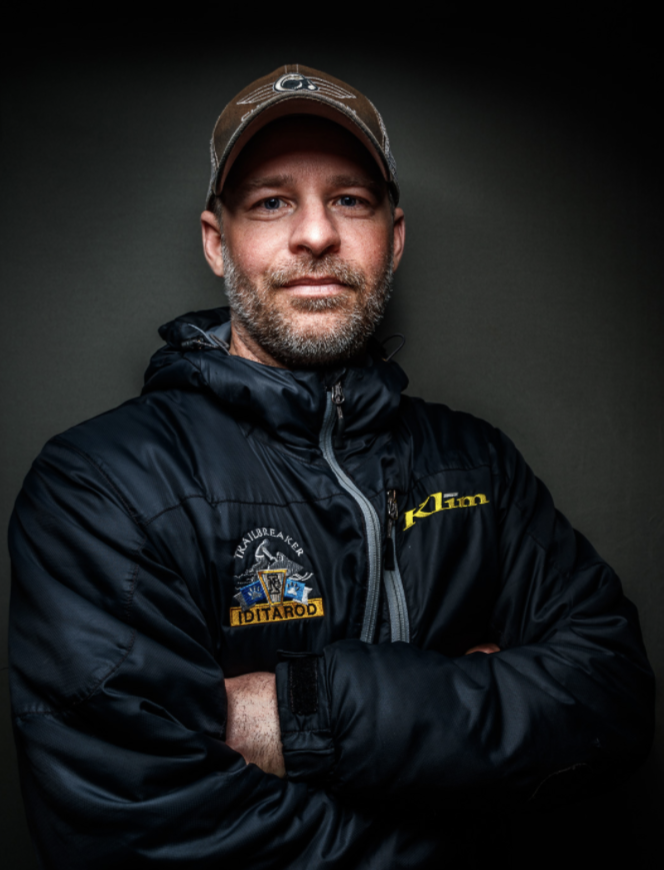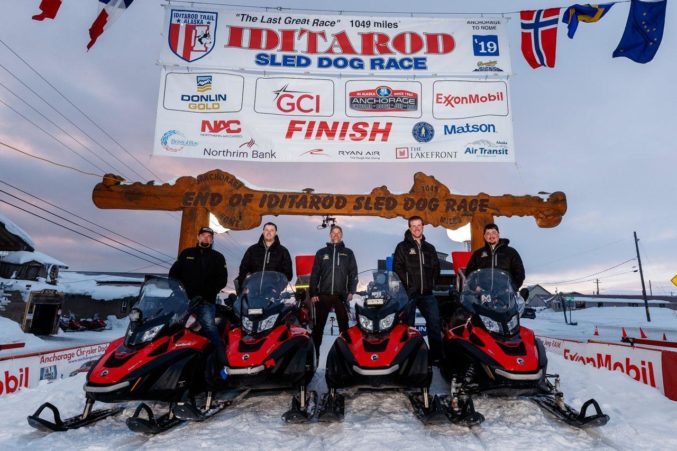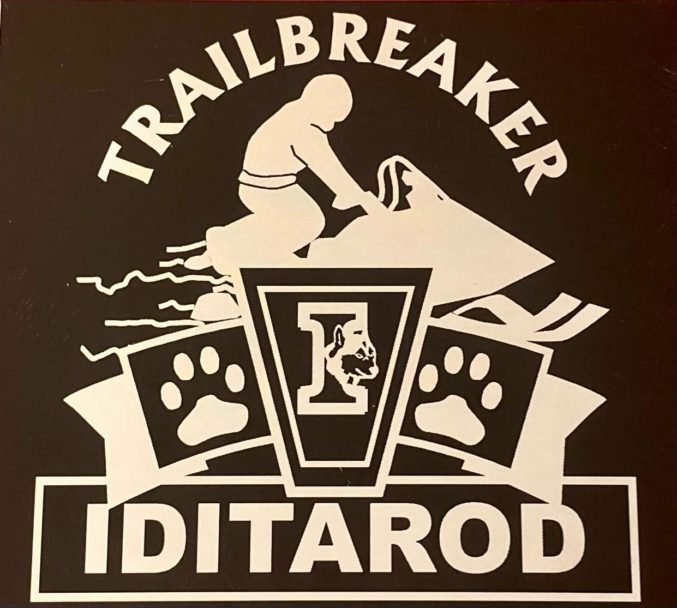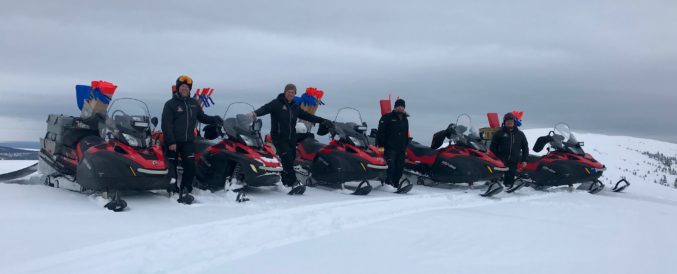
Faces of the Iditarod Copyright 2019 & 2020 by Jeff Schultz Photography Inc.
Spencer Pape has been volunteering with Iditarod for 13 years now. As the lead member of the Iditarod Trail breaker team, he has the first eyes on the trail every year. He and the 5 other trail breakers head out on the trail weeks before the race comes through to make sure there is a clear path for the dog teams to follow. As he says “Mother Nature definitely plays a big part in the trail conditions.” Every year his team repairs and builds bridges over the water, places trail markers and signage, clears overgrowth and deadfall, and lays the route for the mushers. Their work is tedious, yet vital, to get the roughly 1,000 miles of trail ready for the first Saturday in March. A very down-to-Earth guy, he appreciates recognition for his team’s efforts, yet enjoys working behind the scenes stating, “I like to consider the trail breakers as the “Ghosts of the Iditarod”. You can definitely tell that somebody’s been there, but you never see us. We kind of like that.” Here is a little more about Spencer Pape.
Background:
“I was born and raised in Lagrange, Texas. After high school, I went to Sam Houston State University and got a Bachelor’s degree in criminal justice. The year that I graduated, there wasn’t much going on with Texas parks and wildlife. So basically after I got my diploma, I jumped on an airplane and came to Alaska for the summer. Just came up to check it out and be free.
I was in Anchorage for about a week and was looking in the help wanted ads, and there was an ad for a fishing guide at a lodge in remote western Alaska. So I picked up the phone and they hired me sight unseen. I was just kind of thrown to the fire! So I spent the next week in Anchorage going to the parks and merchant mariners school and I got my Captain’s license to drive a boat to be able to take clients for hire.
I turned into a snowbird at an early age. I would come to Alaska in the spring and guide the fishermen all summer long and then jump into the fall hunting season for moose and bear and then I would go back to Texas in the wintertime and I guided waterfowl hunting for a big lodge in south Texas.
So for 9 years I went back and forth, then finally in December of 2007, I met my now wife in the Talkeetna bachelor auction. Which is a whole other story in itself… So we got pretty serious and so I moved full time to Alaska in 2009 and then we got married in 2010, and that’s when I got hooked up with Andy Willis, who was the logistics manager at the time and asked if I wanted to go on an adventure with Iditarod, and I wasn’t going to turn that down! It’s been kind of a snowball effect since then. Every year I have just gotten more and more involved and now I have an official title, ‘Trail Logistics Coordinator for the Iditarod Trail Race’.”
How did you first hear about the Iditarod?

Trailbreaker Team in Nome. Photo Credit: Spencer Pape
I met the Iditarod trail logistics manager (Andy Willis) at the time in 2006, while guiding brown bear hunters in Cold Bay. We continued working together over the years and stayed in touch. In the spring of 2010 the Turquoise lake fire burned over 81,000 acres in the Farewell area, destroying more than 40 miles of the Iditarod trail. That winter, Andy was tasked with putting a crew together to open the trail back up through the burn. Andy called me up and asked if I wanted to go on a little snow machine adventure from McGrath to Rohn and burn a bunch of chainsaw gas. Being that this was only my second winter living in Alaska, I jumped at the opportunity. Little did I know it would take us over 4 weeks to open up 40 miles of trail. Most of the trail was totally unrecognizable and some sections we couldn’t even walk down much less drive a dog team or snow machine with all the burnt blown down trees.
Some of us thought that if the Good Lord were to ever pick up a bunch of matchsticks and just throw a big handful down on the trail, that’s what it looked like except with big giant Spruce trees. There were times where we couldn’t walk through it, we literally just had to cut our way inch by inch. There were parts of it where we couldn’t even tell if there was a trail. The only way we knew there was a trail was we would find burnt reflectors on the trees. So we picked that line and went with it until we found another burnt reflector and finally just straightened it all out.
Still to this day, a lot of that burned spruce is still standing, and every time there is a large wind event, every year there is more and more blowdown. So through that Farewell area, in a good year there would be a good 10-12 inches of snow, but in a bad year it’s dust. It’s never a lot of snow, so it’s mostly just a lot of chainsaw work and cutting deadfall out of the trail. It’s a cool experience.
What is your favorite aspect of volunteering?

Image courtesy of Spencer Pape
“Getting to travel across Alaska on a snow machine and seeing some of the most remote areas in the state and maybe even the United States. The trail spans over 1,000 miles and there’s just so many aspects along the way. You literally go from salt water, and end at salt water. But it’s the in-between that goes from river valleys to high mountain passes in the Alaska Range (over 3,000 feet when we go through the pass there). Then back down through rolling hills and across tundra flats and down the mighty Yukon, or up the mighty Yukon depending on the year and which route we are doing. Then finally ending up back on the coast going across a frozen sound which is an eerie feeling at times because you don’t know which way is up if it’s a ground blizzard. In a ground blizzard it always feels like you are going uphill, but you’re on Norton Sound, and you know it’s all flat because you are on ice. It’s weird, but it’s pretty neat going from the tundra lowlands to the high mountains to the coast.”
What keeps you coming back every year?
“The adventure! I’ve made 12 trips up the trail and every year it’s different. We start working on the trail in early winter. We’ll do our first trip mid-February and try to get in front of the Iron Dog Race to help straighten the trail and pack it down. That race will use roughly 90% of the same trail, and their race is 2 weeks before the Iditarod. The only section of trail they don’t use is Rainy Pass. [Iron Dog] will go though Ptarmigan Pass and Hell’s Gate instead of through Rainy Pass. Then we’ll go and punch the trail over the top of the Alaska Range and down the back side of Rainy Pass and the gorge. Mainly because that’s the section of the trail that takes so much work. That will take us about a week. Then we’ll come back home for a bit before we head out again in front of the dogs. Then we’ll take off 3 or 4 days in front of the dogs. Then we’re ahead of the dogs all the way [to the finish]. The only time we’ll ever get to see a dog is at the finish line in Nome.
Yet, the weather, wildlife, remoteness and trail conditions make it the wildest, craziest, harshest adventure I’ve ever been on. Or maybe I enjoy being uncomfortable way too much. A buddy once told me ‘if you’re going to be dumb, ya better be tough’.”

Photo credit: Spencer Pape
What is your favorite moment or story from the trail?
“The 2014 race. It was looking like Jeff King had it in the bag. Aliy was an hour behind Jeff coming into White Mountain and Dallas was an hour behind her. The trail breakers were just waking up when Jeff came into White Mountain. As we started to gear up and break trail to Nome, Aliy came in. With a high wind report predicted for the coast, we all parked our snow machines down on the river to regroup, load our lathe boxes and throw on an extra layer. Knowing that the Soloman blow hole is a wickedly miserable stretch of trail when it blows. Aliy was still tending to her team as we started to roll out of the White Mountain checkpoint. I idled up to within an ear shout and wished her the best of luck. Sure enough, it became a complete whiteout as we came over the last hill and dropped down to the beach. With the visibility being so poor we started chainsawing holes in the ice to make sure the lathe (trail markers) stayed put in the high winds. Jeff was in the lead when he hit the beach but the winds had picked up. Jeff and his team kept getting blown off the trail and getting tangled up in the driftwood piles. Aliy ended up passing Jeff on the beach and never knew it. She never saw him and was the first into the checkpoint of Safety. As Aliy tucked her team on the leaside of the checkpoint to rest her dogs and take a break from the wind, Dallas came in. He too had passed Jeff in the storm and never knew it. Dallas, thinking he was in third place, put on his bib and checked out of Safety and headed for Nome to try and run down the leaders. Dallas had no idea that he had won Iditarod 42 when he crossed the line. The look on his face was unforgettable!”
Teachers: With weather playing an integral part of the race each year, and the Trail breakers try to keep the trail clear, check out this lesson about weather from Kelly Villar. Weather lesson


